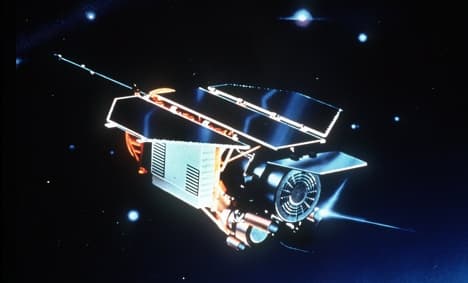German satellite falling toward Earth

A German satellite the size of a car re-entered the Earth's atmosphere early Sunday, officials said, adding they did not know yet if any debris had hit the Earth.
The Röntgen Satellite (ROSAT), an X-ray observatory, made its re-entry between 1:45 GMT and 2:15 GMT on Sunday, the German Aerospace Centre (DLR) said in a statement.
"There is currently no confirmation if pieces of debris have reached Earth's surface," the statement added.
According to estimates cited last week, as many as 30 individual pieces weighing a total of 1.7 tonnes could reach the surface of the Earth.
But Andreas Schütz, spokesman for the DLR, said they would have to "wait for data in the next days" to know when and where the debris could fall.
Last week, DLR officials said ROSAT was expected to return to Earth between October 22 and 23, travelling at a speed of about 28,000 kilometres (17,000 miles) per hour.
Solar radiation, which heats up the Earth's atmosphere, increases the atmospheric drag and makes it hard to estimate the date of re-entry.
As the spacecraft re-enters the atmosphere, the x-ray observatory would break up into pieces, some of which will burn up, they said.
"The largest single fragment will probably be the telescope's mirror, which is very heat resistant," it added.
However, statistically speaking, there is very little danger to humans from space junk, experts have said. The debris will almost certainly fall in the sea or on an uninhabited piece of land.
During its mission, ROSAT operated at distances of up to 585 kilometres above Earth's surface, but it has lost altitude since its decommissioning, and in June 2011 it was about 327 kilometres above the ground.
A controlled re-entry was not possible at the end of its mission in 1999 because the spacecraft does not have a propulsion system on board, the officials said.
ROSAT was launched in June 1990 to allow researchers to perform an all-sky survey of X-ray sources with an imaging telescope for the first time.
Last month, a bus-sized US satellite that hurtled unpredictably toward Earth crossed over Africa and the northern Atlantic before plunging into the Pacific Ocean off California, NASA said.
There were no sightings or reliable accounts of damage as the six-tonne Upper Atmosphere Research Satellite (UARS) fell from the sky.
Comments
See Also
The Röntgen Satellite (ROSAT), an X-ray observatory, made its re-entry between 1:45 GMT and 2:15 GMT on Sunday, the German Aerospace Centre (DLR) said in a statement.
"There is currently no confirmation if pieces of debris have reached Earth's surface," the statement added.
According to estimates cited last week, as many as 30 individual pieces weighing a total of 1.7 tonnes could reach the surface of the Earth.
But Andreas Schütz, spokesman for the DLR, said they would have to "wait for data in the next days" to know when and where the debris could fall.
Last week, DLR officials said ROSAT was expected to return to Earth between October 22 and 23, travelling at a speed of about 28,000 kilometres (17,000 miles) per hour.
Solar radiation, which heats up the Earth's atmosphere, increases the atmospheric drag and makes it hard to estimate the date of re-entry.
As the spacecraft re-enters the atmosphere, the x-ray observatory would break up into pieces, some of which will burn up, they said.
"The largest single fragment will probably be the telescope's mirror, which is very heat resistant," it added.
However, statistically speaking, there is very little danger to humans from space junk, experts have said. The debris will almost certainly fall in the sea or on an uninhabited piece of land.
During its mission, ROSAT operated at distances of up to 585 kilometres above Earth's surface, but it has lost altitude since its decommissioning, and in June 2011 it was about 327 kilometres above the ground.
A controlled re-entry was not possible at the end of its mission in 1999 because the spacecraft does not have a propulsion system on board, the officials said.
ROSAT was launched in June 1990 to allow researchers to perform an all-sky survey of X-ray sources with an imaging telescope for the first time.
Last month, a bus-sized US satellite that hurtled unpredictably toward Earth crossed over Africa and the northern Atlantic before plunging into the Pacific Ocean off California, NASA said.
There were no sightings or reliable accounts of damage as the six-tonne Upper Atmosphere Research Satellite (UARS) fell from the sky.
Join the conversation in our comments section below. Share your own views and experience and if you have a question or suggestion for our journalists then email us at [email protected].
Please keep comments civil, constructive and on topic – and make sure to read our terms of use before getting involved.
Please log in here to leave a comment.